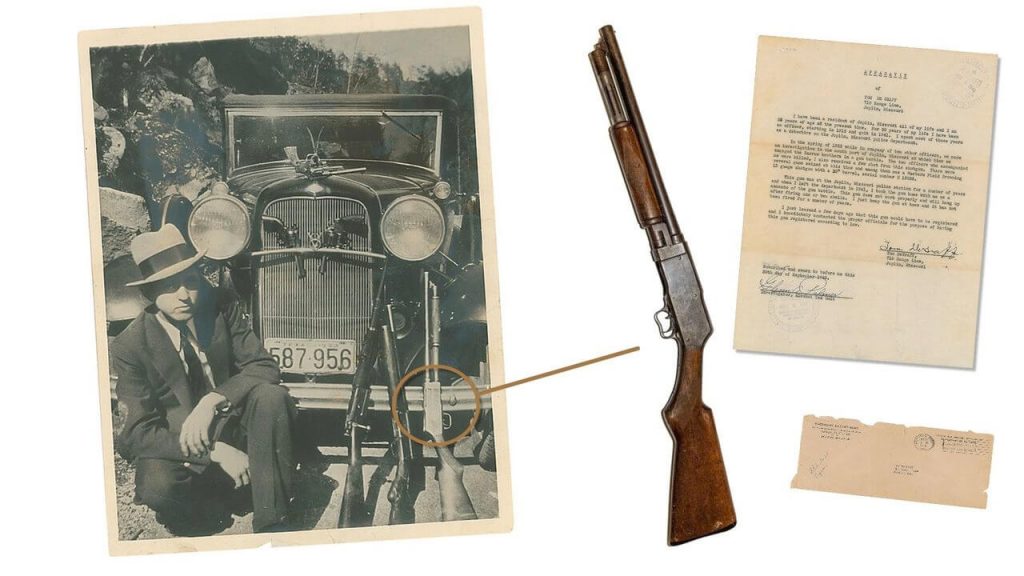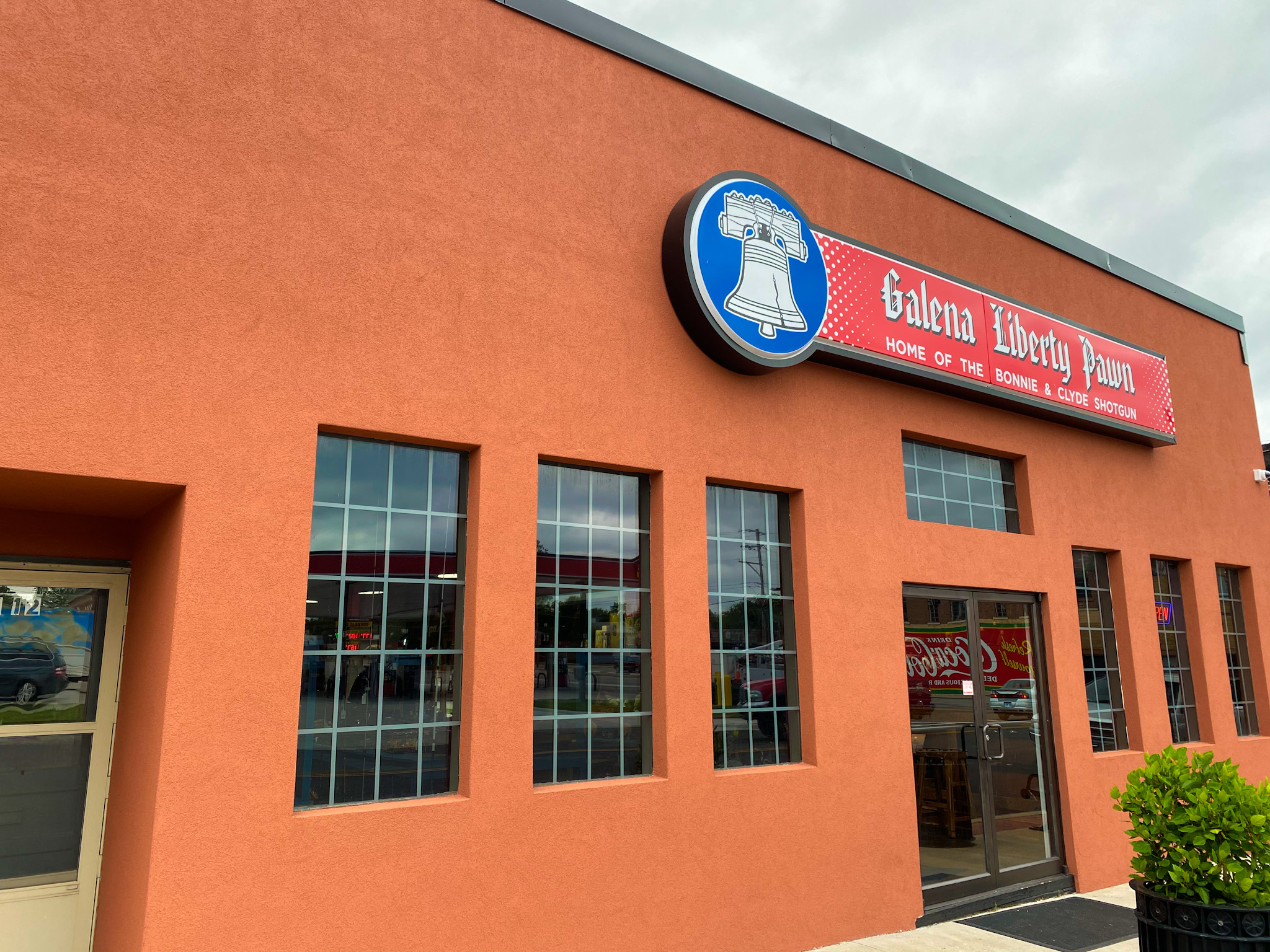The Bonnie & Clyde Shotgun
Best Pawn Shop | Galena KS | Galena Liberty Pawn
The Bonnie & Clyde Shotgun – History of the Firearm
 Tom De Graff was a detective with the Joplin, Missouri Police Department when, on April 13, 1933, he, along with Newton County Constable Wes Harryman, Joplin PD Detective Harry McGinnis, and Missouri Highway Patrolmen W.E. Grammer and George Kahler, attempted to execute a search warrant at an apartment rented by a group of men and women in south Joplin. The warrant had been issued after receipt of a tip that a car matching the description of one used during a burglary at the Neosho Milling Company had been seen in the garage beneath the apartment. Upon their arrival, Harryman exited the vehicle he shared with McGinnis and De Graff, and approached an unidentified man who began closing the garage door upon spotting them. Almost immediately, Harryman was mortally wounded by a shotgun blast, and McGinnis, who was following, was killed by a second shotgun round. The two Highway Patrolmen joined De Graff, who had taken a few pellets during the opening volley, and worked their way around to the side of the building exchanging fire as they did so (W.D. Jones was hit in the side, Buck Barrow was grazed by a bullet, and Clyde Barrow was saved when his coat button deflected a bullet). Eventually, the occupants smashed their way through the garage door in their car and sped away amidst a hail of gunfire from the surviving law enforcement officers. According to the St. Louis Post-Dispatch of April 14, 1933, a search of the building yielded “an automatic rifle, four rifles, a sawed-off shotgun and a revolver.” De Graff expands on this in his affidavit: “In the spring of 1933 while in the company of two other officers, we made an investigation in the south part of Joplin, Missouri at which time we engaged the Barrow brothers in a gun battle. The two officers who accompanied me were killed, I also received a few shots from this shotgun. There were several guns seized at this time and among them was a Western Field Browning 12 guage (sic) shotgun with 15” barrel, serial number U 12034.” According to the affidavit, the shotgun remained at the Joplin Police Department until De Graff left the department in 1941 when he took the gun with him “as a memento of the gun battle.” It is interesting to note that the famous photographs of Clyde Barrow and W.D. Jones in front of their automobile with their assembled arsenal (found at the site of the Joplin shootout) distinctly shows a sawed-off, slide-action Savage-Stevens Model 520 type shotgun propped up against the bumper on the far right. The Western Field Browning Model 30 was a store branded version of the Model 520 made for Montgomery Ward, and there is little doubt that this is the very gun photographed with the Barrow brothers. This is an extremely important piece in the history of Bonnie and Clyde, and would make a stellar centerpiece for any collection of US criminal justice artifacts.
Tom De Graff was a detective with the Joplin, Missouri Police Department when, on April 13, 1933, he, along with Newton County Constable Wes Harryman, Joplin PD Detective Harry McGinnis, and Missouri Highway Patrolmen W.E. Grammer and George Kahler, attempted to execute a search warrant at an apartment rented by a group of men and women in south Joplin. The warrant had been issued after receipt of a tip that a car matching the description of one used during a burglary at the Neosho Milling Company had been seen in the garage beneath the apartment. Upon their arrival, Harryman exited the vehicle he shared with McGinnis and De Graff, and approached an unidentified man who began closing the garage door upon spotting them. Almost immediately, Harryman was mortally wounded by a shotgun blast, and McGinnis, who was following, was killed by a second shotgun round. The two Highway Patrolmen joined De Graff, who had taken a few pellets during the opening volley, and worked their way around to the side of the building exchanging fire as they did so (W.D. Jones was hit in the side, Buck Barrow was grazed by a bullet, and Clyde Barrow was saved when his coat button deflected a bullet). Eventually, the occupants smashed their way through the garage door in their car and sped away amidst a hail of gunfire from the surviving law enforcement officers. According to the St. Louis Post-Dispatch of April 14, 1933, a search of the building yielded “an automatic rifle, four rifles, a sawed-off shotgun and a revolver.” De Graff expands on this in his affidavit: “In the spring of 1933 while in the company of two other officers, we made an investigation in the south part of Joplin, Missouri at which time we engaged the Barrow brothers in a gun battle. The two officers who accompanied me were killed, I also received a few shots from this shotgun. There were several guns seized at this time and among them was a Western Field Browning 12 guage (sic) shotgun with 15” barrel, serial number U 12034.” According to the affidavit, the shotgun remained at the Joplin Police Department until De Graff left the department in 1941 when he took the gun with him “as a memento of the gun battle.” It is interesting to note that the famous photographs of Clyde Barrow and W.D. Jones in front of their automobile with their assembled arsenal (found at the site of the Joplin shootout) distinctly shows a sawed-off, slide-action Savage-Stevens Model 520 type shotgun propped up against the bumper on the far right. The Western Field Browning Model 30 was a store branded version of the Model 520 made for Montgomery Ward, and there is little doubt that this is the very gun photographed with the Barrow brothers. This is an extremely important piece in the history of Bonnie and Clyde, and would make a stellar centerpiece for any collection of US criminal justice artifacts.
Bonnie Parker and Clyde Barrow’s Western Field Browning Model 30 Shotgun, captured after the 1933 Joplin shootout by Detective Tom De Graff. Serial #U 12034, 12 Ga., 15 1/2″ barrel with a good bore that has spots of freckling along its length. The metal has an overall mottled gray-brown patina with areas of pinprick pitting throughout, but most noticeable on the right side of the frame behind the ejection port, as well as traces of original blue left on protected areas. Additionally, the magazine tube has areas of bright gray along the bearing surfaces of the slide. The frame markings are nevertheless still clear and fairly crisp, and the barrel was shortened to a more easily concealable length by the Barrow Gang prior to its capture. The trigger guard has a pronounced upwards bend along the bow indicating a heavy impact, possibly incurred during the Joplin gunfight. The walnut buttstock and checkered slide have numerous small handling marks and minor surface blemishes throughout, and moderate-heavy flattening of the checkering points on both the slide and pistol-grip. The original varnish and the original grooved, hard rubber buttplate are still present. The action is functional, however the 1946 NFA registration affidavit written by De Graff states that the gun will jam after “firing one or two shells” due to an unspecified mechanical fault, possibly related to the impact described above. Includes the original registration affidavit paperwork authenticating the serial number.


We’d love to hear from you. Please fill out the form on this page with questions, comments, and inquiry about our products. Thanks for your interest!